BUS300: Strategic Analysis of Apple Inc. - Final Report
VerifiedAdded on 2021/03/08
|10
|4332
|217
Report
AI Summary
This report provides a strategic analysis of Apple Inc., examining its external and internal environments. The analysis begins with an introduction to Apple's history and impact on technology. It then delves into the industry overview, industry life cycle, and Porter's Five Forces, assessing competition, threats, and bargaining power. The report also explores potential external risks in Apple's supply chain. The internal analysis covers Apple's vision, mission, values, and core competencies, including its "Think Different" philosophy. A SWOT analysis highlights the company's strengths (financial position, product differentiation, brand image, retail approach, and integrated development), weaknesses (executive changes, protective strategy, product information security), opportunities (loyal customers, untapped markets), and threats (competition from Google Android and Microsoft). The report concludes by providing a comprehensive overview of Apple's strategic position and market dynamics.
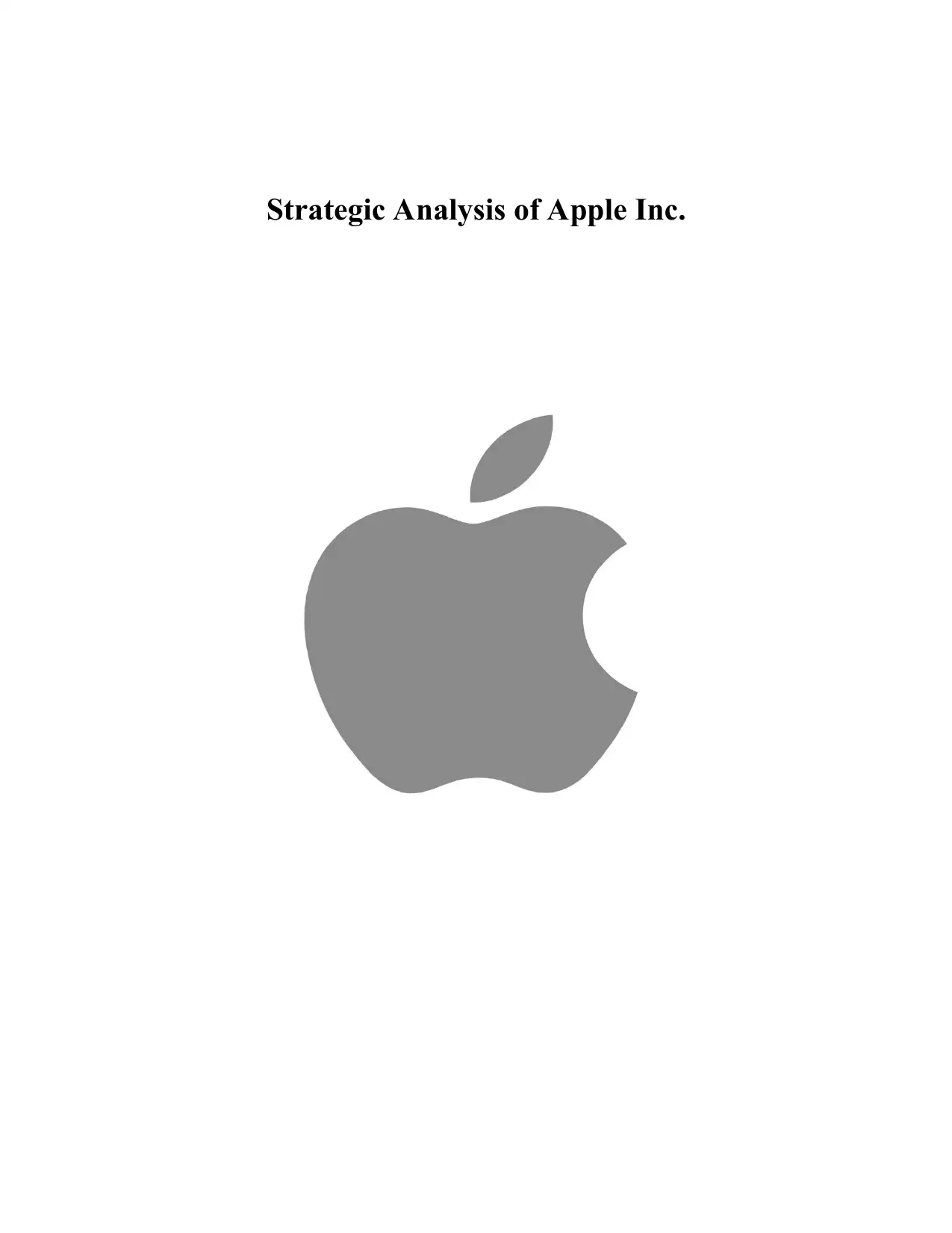
Strategic Analysis of Apple Inc.
Paraphrase This Document
Need a fresh take? Get an instant paraphrase of this document with our AI Paraphraser
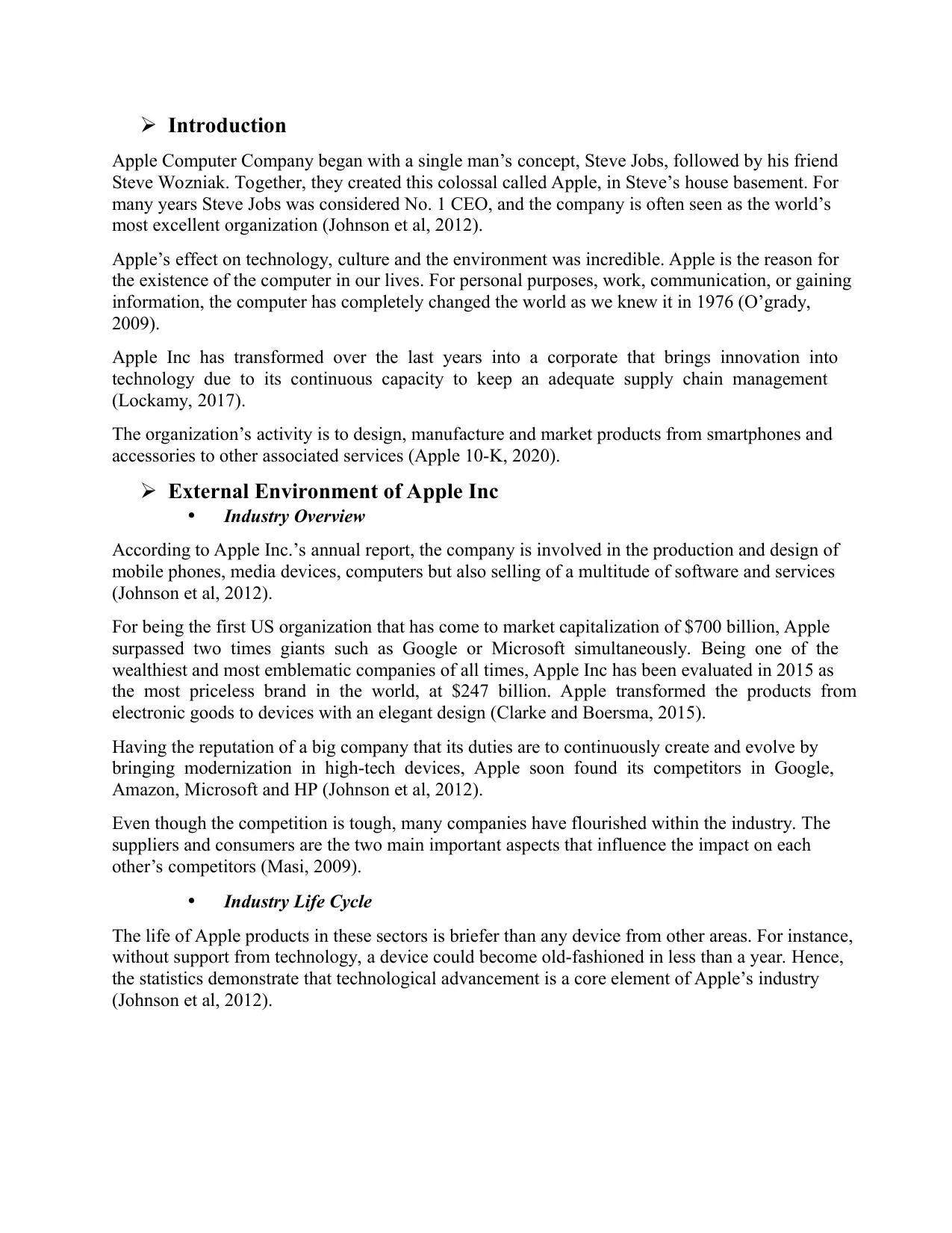
Introduction
Apple Computer Company began with a single man’s concept, Steve Jobs, followed by his friend
Steve Wozniak. Together, they created this colossal called Apple, in Steve’s house basement. For
many years Steve Jobs was considered No. 1 CEO, and the company is often seen as the world’s
most excellent organization (Johnson et al, 2012).
Apple’s effect on technology, culture and the environment was incredible. Apple is the reason for
the existence of the computer in our lives. For personal purposes, work, communication, or gaining
information, the computer has completely changed the world as we knew it in 1976 (O’grady,
2009).
Apple Inc has transformed over the last years into a corporate that brings innovation into
technology due to its continuous capacity to keep an adequate supply chain management
(Lockamy, 2017).
The organization’s activity is to design, manufacture and market products from smartphones and
accessories to other associated services (Apple 10-K, 2020).
External Environment of Apple Inc
• Industry Overview
According to Apple Inc.’s annual report, the company is involved in the production and design of
mobile phones, media devices, computers but also selling of a multitude of software and services
(Johnson et al, 2012).
For being the first US organization that has come to market capitalization of $700 billion, Apple
surpassed two times giants such as Google or Microsoft simultaneously. Being one of the
wealthiest and most emblematic companies of all times, Apple Inc has been evaluated in 2015 as
the most priceless brand in the world, at $247 billion. Apple transformed the products from
electronic goods to devices with an elegant design (Clarke and Boersma, 2015).
Having the reputation of a big company that its duties are to continuously create and evolve by
bringing modernization in high-tech devices, Apple soon found its competitors in Google,
Amazon, Microsoft and HP (Johnson et al, 2012).
Even though the competition is tough, many companies have flourished within the industry. The
suppliers and consumers are the two main important aspects that influence the impact on each
other’s competitors (Masi, 2009).
• Industry Life Cycle
The life of Apple products in these sectors is briefer than any device from other areas. For instance,
without support from technology, a device could become old-fashioned in less than a year. Hence,
the statistics demonstrate that technological advancement is a core element of Apple’s industry
(Johnson et al, 2012).
Apple Computer Company began with a single man’s concept, Steve Jobs, followed by his friend
Steve Wozniak. Together, they created this colossal called Apple, in Steve’s house basement. For
many years Steve Jobs was considered No. 1 CEO, and the company is often seen as the world’s
most excellent organization (Johnson et al, 2012).
Apple’s effect on technology, culture and the environment was incredible. Apple is the reason for
the existence of the computer in our lives. For personal purposes, work, communication, or gaining
information, the computer has completely changed the world as we knew it in 1976 (O’grady,
2009).
Apple Inc has transformed over the last years into a corporate that brings innovation into
technology due to its continuous capacity to keep an adequate supply chain management
(Lockamy, 2017).
The organization’s activity is to design, manufacture and market products from smartphones and
accessories to other associated services (Apple 10-K, 2020).
External Environment of Apple Inc
• Industry Overview
According to Apple Inc.’s annual report, the company is involved in the production and design of
mobile phones, media devices, computers but also selling of a multitude of software and services
(Johnson et al, 2012).
For being the first US organization that has come to market capitalization of $700 billion, Apple
surpassed two times giants such as Google or Microsoft simultaneously. Being one of the
wealthiest and most emblematic companies of all times, Apple Inc has been evaluated in 2015 as
the most priceless brand in the world, at $247 billion. Apple transformed the products from
electronic goods to devices with an elegant design (Clarke and Boersma, 2015).
Having the reputation of a big company that its duties are to continuously create and evolve by
bringing modernization in high-tech devices, Apple soon found its competitors in Google,
Amazon, Microsoft and HP (Johnson et al, 2012).
Even though the competition is tough, many companies have flourished within the industry. The
suppliers and consumers are the two main important aspects that influence the impact on each
other’s competitors (Masi, 2009).
• Industry Life Cycle
The life of Apple products in these sectors is briefer than any device from other areas. For instance,
without support from technology, a device could become old-fashioned in less than a year. Hence,
the statistics demonstrate that technological advancement is a core element of Apple’s industry
(Johnson et al, 2012).
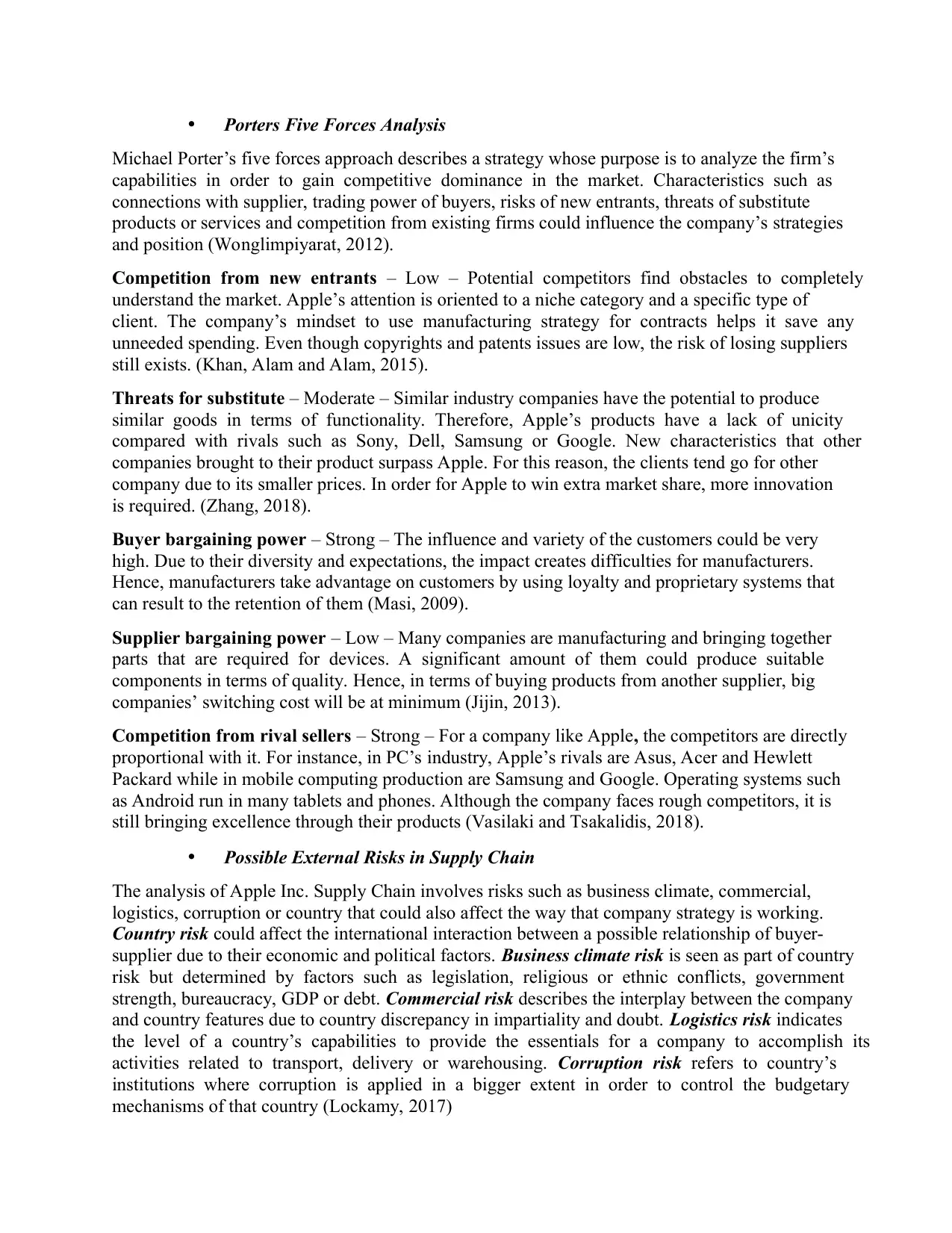
• Porters Five Forces Analysis
Michael Porter’s five forces approach describes a strategy whose purpose is to analyze the firm’s
capabilities in order to gain competitive dominance in the market. Characteristics such as
connections with supplier, trading power of buyers, risks of new entrants, threats of substitute
products or services and competition from existing firms could influence the company’s strategies
and position (Wonglimpiyarat, 2012).
Competition from new entrants – Low – Potential competitors find obstacles to completely
understand the market. Apple’s attention is oriented to a niche category and a specific type of
client. The company’s mindset to use manufacturing strategy for contracts helps it save any
unneeded spending. Even though copyrights and patents issues are low, the risk of losing suppliers
still exists. (Khan, Alam and Alam, 2015).
Threats for substitute – Moderate – Similar industry companies have the potential to produce
similar goods in terms of functionality. Therefore, Apple’s products have a lack of unicity
compared with rivals such as Sony, Dell, Samsung or Google. New characteristics that other
companies brought to their product surpass Apple. For this reason, the clients tend go for other
company due to its smaller prices. In order for Apple to win extra market share, more innovation
is required. (Zhang, 2018).
Buyer bargaining power – Strong – The influence and variety of the customers could be very
high. Due to their diversity and expectations, the impact creates difficulties for manufacturers.
Hence, manufacturers take advantage on customers by using loyalty and proprietary systems that
can result to the retention of them (Masi, 2009).
Supplier bargaining power – Low – Many companies are manufacturing and bringing together
parts that are required for devices. A significant amount of them could produce suitable
components in terms of quality. Hence, in terms of buying products from another supplier, big
companies’ switching cost will be at minimum (Jijin, 2013).
Competition from rival sellers – Strong – For a company like Apple, the competitors are directly
proportional with it. For instance, in PC’s industry, Apple’s rivals are Asus, Acer and Hewlett
Packard while in mobile computing production are Samsung and Google. Operating systems such
as Android run in many tablets and phones. Although the company faces rough competitors, it is
still bringing excellence through their products (Vasilaki and Tsakalidis, 2018).
• Possible External Risks in Supply Chain
The analysis of Apple Inc. Supply Chain involves risks such as business climate, commercial,
logistics, corruption or country that could also affect the way that company strategy is working.
Country risk could affect the international interaction between a possible relationship of buyer-
supplier due to their economic and political factors. Business climate risk is seen as part of country
risk but determined by factors such as legislation, religious or ethnic conflicts, government
strength, bureaucracy, GDP or debt. Commercial risk describes the interplay between the company
and country features due to country discrepancy in impartiality and doubt. Logistics risk indicates
the level of a country’s capabilities to provide the essentials for a company to accomplish its
activities related to transport, delivery or warehousing. Corruption risk refers to country’s
institutions where corruption is applied in a bigger extent in order to control the budgetary
mechanisms of that country (Lockamy, 2017)
Michael Porter’s five forces approach describes a strategy whose purpose is to analyze the firm’s
capabilities in order to gain competitive dominance in the market. Characteristics such as
connections with supplier, trading power of buyers, risks of new entrants, threats of substitute
products or services and competition from existing firms could influence the company’s strategies
and position (Wonglimpiyarat, 2012).
Competition from new entrants – Low – Potential competitors find obstacles to completely
understand the market. Apple’s attention is oriented to a niche category and a specific type of
client. The company’s mindset to use manufacturing strategy for contracts helps it save any
unneeded spending. Even though copyrights and patents issues are low, the risk of losing suppliers
still exists. (Khan, Alam and Alam, 2015).
Threats for substitute – Moderate – Similar industry companies have the potential to produce
similar goods in terms of functionality. Therefore, Apple’s products have a lack of unicity
compared with rivals such as Sony, Dell, Samsung or Google. New characteristics that other
companies brought to their product surpass Apple. For this reason, the clients tend go for other
company due to its smaller prices. In order for Apple to win extra market share, more innovation
is required. (Zhang, 2018).
Buyer bargaining power – Strong – The influence and variety of the customers could be very
high. Due to their diversity and expectations, the impact creates difficulties for manufacturers.
Hence, manufacturers take advantage on customers by using loyalty and proprietary systems that
can result to the retention of them (Masi, 2009).
Supplier bargaining power – Low – Many companies are manufacturing and bringing together
parts that are required for devices. A significant amount of them could produce suitable
components in terms of quality. Hence, in terms of buying products from another supplier, big
companies’ switching cost will be at minimum (Jijin, 2013).
Competition from rival sellers – Strong – For a company like Apple, the competitors are directly
proportional with it. For instance, in PC’s industry, Apple’s rivals are Asus, Acer and Hewlett
Packard while in mobile computing production are Samsung and Google. Operating systems such
as Android run in many tablets and phones. Although the company faces rough competitors, it is
still bringing excellence through their products (Vasilaki and Tsakalidis, 2018).
• Possible External Risks in Supply Chain
The analysis of Apple Inc. Supply Chain involves risks such as business climate, commercial,
logistics, corruption or country that could also affect the way that company strategy is working.
Country risk could affect the international interaction between a possible relationship of buyer-
supplier due to their economic and political factors. Business climate risk is seen as part of country
risk but determined by factors such as legislation, religious or ethnic conflicts, government
strength, bureaucracy, GDP or debt. Commercial risk describes the interplay between the company
and country features due to country discrepancy in impartiality and doubt. Logistics risk indicates
the level of a country’s capabilities to provide the essentials for a company to accomplish its
activities related to transport, delivery or warehousing. Corruption risk refers to country’s
institutions where corruption is applied in a bigger extent in order to control the budgetary
mechanisms of that country (Lockamy, 2017)
⊘ This is a preview!⊘
Do you want full access?
Subscribe today to unlock all pages.

Trusted by 1+ million students worldwide
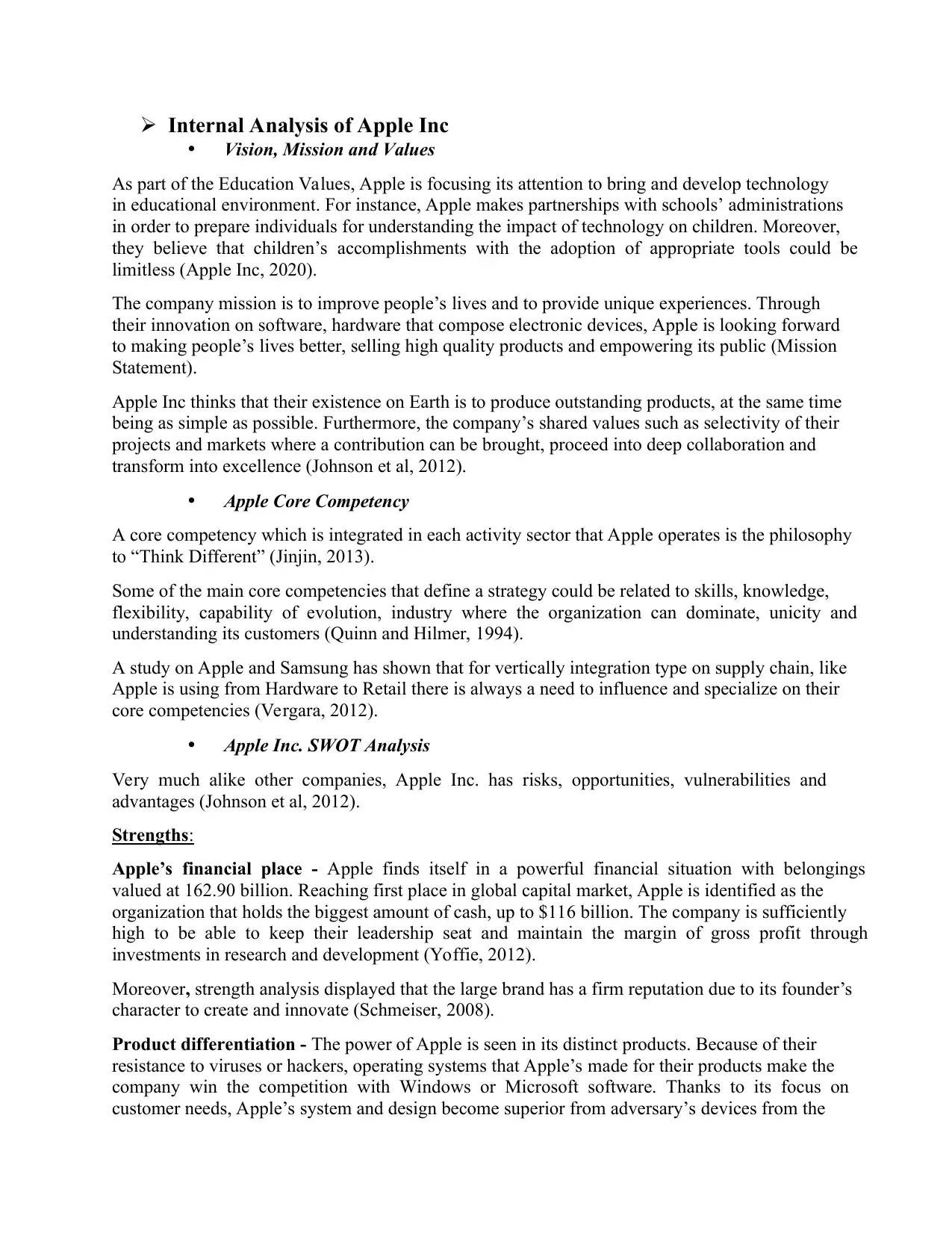
Internal Analysis of Apple Inc
• Vision, Mission and Values
As part of the Education Values, Apple is focusing its attention to bring and develop technology
in educational environment. For instance, Apple makes partnerships with schools’ administrations
in order to prepare individuals for understanding the impact of technology on children. Moreover,
they believe that children’s accomplishments with the adoption of appropriate tools could be
limitless (Apple Inc, 2020).
The company mission is to improve people’s lives and to provide unique experiences. Through
their innovation on software, hardware that compose electronic devices, Apple is looking forward
to making people’s lives better, selling high quality products and empowering its public (Mission
Statement).
Apple Inc thinks that their existence on Earth is to produce outstanding products, at the same time
being as simple as possible. Furthermore, the company’s shared values such as selectivity of their
projects and markets where a contribution can be brought, proceed into deep collaboration and
transform into excellence (Johnson et al, 2012).
• Apple Core Competency
A core competency which is integrated in each activity sector that Apple operates is the philosophy
to “Think Different” (Jinjin, 2013).
Some of the main core competencies that define a strategy could be related to skills, knowledge,
flexibility, capability of evolution, industry where the organization can dominate, unicity and
understanding its customers (Quinn and Hilmer, 1994).
A study on Apple and Samsung has shown that for vertically integration type on supply chain, like
Apple is using from Hardware to Retail there is always a need to influence and specialize on their
core competencies (Vergara, 2012).
• Apple Inc. SWOT Analysis
Very much alike other companies, Apple Inc. has risks, opportunities, vulnerabilities and
advantages (Johnson et al, 2012).
Strengths:
Apple’s financial place - Apple finds itself in a powerful financial situation with belongings
valued at 162.90 billion. Reaching first place in global capital market, Apple is identified as the
organization that holds the biggest amount of cash, up to $116 billion. The company is sufficiently
high to be able to keep their leadership seat and maintain the margin of gross profit through
investments in research and development (Yoffie, 2012).
Moreover, strength analysis displayed that the large brand has a firm reputation due to its founder’s
character to create and innovate (Schmeiser, 2008).
Product differentiation - The power of Apple is seen in its distinct products. Because of their
resistance to viruses or hackers, operating systems that Apple’s made for their products make the
company win the competition with Windows or Microsoft software. Thanks to its focus on
customer needs, Apple’s system and design become superior from adversary’s devices from the
• Vision, Mission and Values
As part of the Education Values, Apple is focusing its attention to bring and develop technology
in educational environment. For instance, Apple makes partnerships with schools’ administrations
in order to prepare individuals for understanding the impact of technology on children. Moreover,
they believe that children’s accomplishments with the adoption of appropriate tools could be
limitless (Apple Inc, 2020).
The company mission is to improve people’s lives and to provide unique experiences. Through
their innovation on software, hardware that compose electronic devices, Apple is looking forward
to making people’s lives better, selling high quality products and empowering its public (Mission
Statement).
Apple Inc thinks that their existence on Earth is to produce outstanding products, at the same time
being as simple as possible. Furthermore, the company’s shared values such as selectivity of their
projects and markets where a contribution can be brought, proceed into deep collaboration and
transform into excellence (Johnson et al, 2012).
• Apple Core Competency
A core competency which is integrated in each activity sector that Apple operates is the philosophy
to “Think Different” (Jinjin, 2013).
Some of the main core competencies that define a strategy could be related to skills, knowledge,
flexibility, capability of evolution, industry where the organization can dominate, unicity and
understanding its customers (Quinn and Hilmer, 1994).
A study on Apple and Samsung has shown that for vertically integration type on supply chain, like
Apple is using from Hardware to Retail there is always a need to influence and specialize on their
core competencies (Vergara, 2012).
• Apple Inc. SWOT Analysis
Very much alike other companies, Apple Inc. has risks, opportunities, vulnerabilities and
advantages (Johnson et al, 2012).
Strengths:
Apple’s financial place - Apple finds itself in a powerful financial situation with belongings
valued at 162.90 billion. Reaching first place in global capital market, Apple is identified as the
organization that holds the biggest amount of cash, up to $116 billion. The company is sufficiently
high to be able to keep their leadership seat and maintain the margin of gross profit through
investments in research and development (Yoffie, 2012).
Moreover, strength analysis displayed that the large brand has a firm reputation due to its founder’s
character to create and innovate (Schmeiser, 2008).
Product differentiation - The power of Apple is seen in its distinct products. Because of their
resistance to viruses or hackers, operating systems that Apple’s made for their products make the
company win the competition with Windows or Microsoft software. Thanks to its focus on
customer needs, Apple’s system and design become superior from adversary’s devices from the
Paraphrase This Document
Need a fresh take? Get an instant paraphrase of this document with our AI Paraphraser
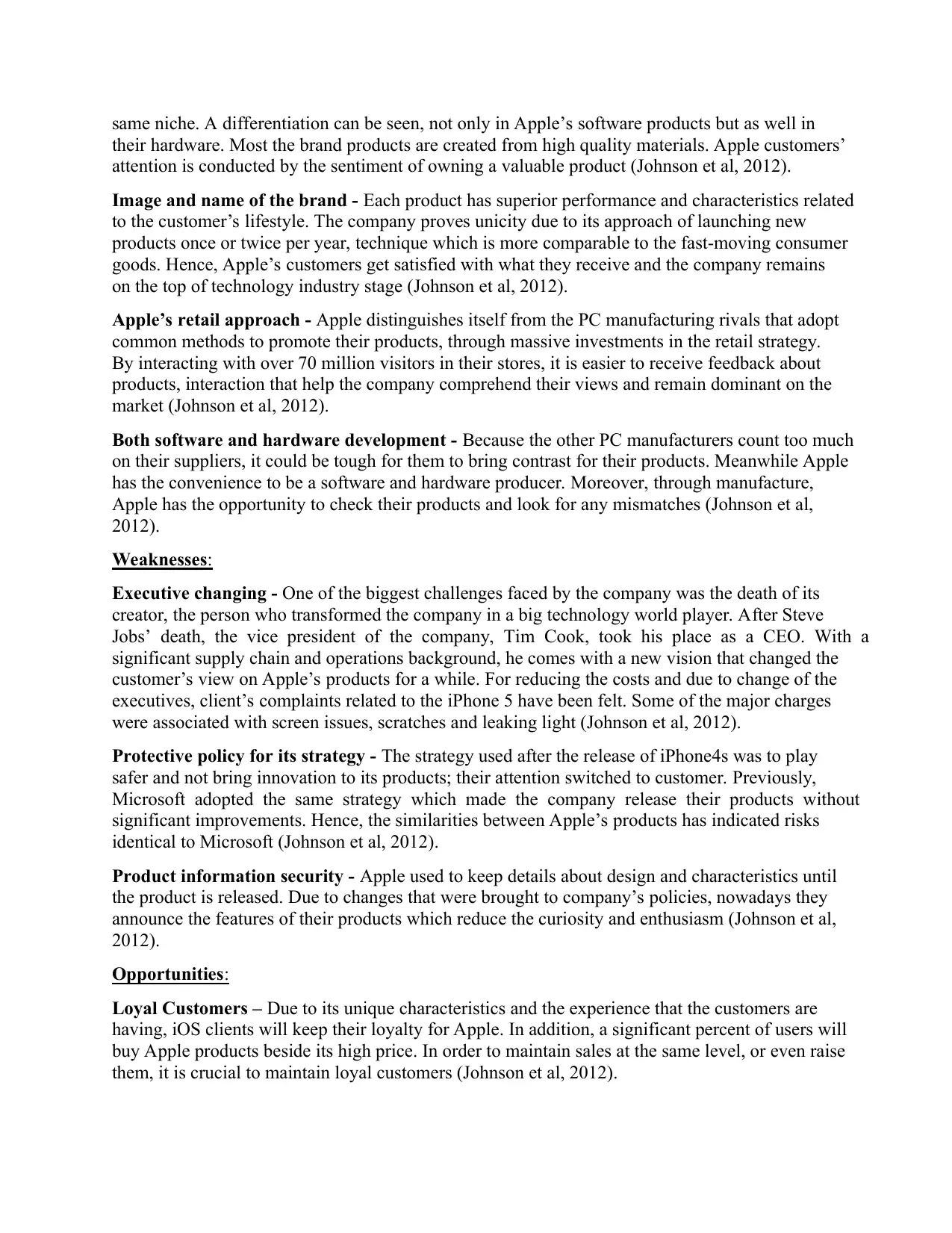
same niche. A differentiation can be seen, not only in Apple’s software products but as well in
their hardware. Most the brand products are created from high quality materials. Apple customers’
attention is conducted by the sentiment of owning a valuable product (Johnson et al, 2012).
Image and name of the brand - Each product has superior performance and characteristics related
to the customer’s lifestyle. The company proves unicity due to its approach of launching new
products once or twice per year, technique which is more comparable to the fast-moving consumer
goods. Hence, Apple’s customers get satisfied with what they receive and the company remains
on the top of technology industry stage (Johnson et al, 2012).
Apple’s retail approach - Apple distinguishes itself from the PC manufacturing rivals that adopt
common methods to promote their products, through massive investments in the retail strategy.
By interacting with over 70 million visitors in their stores, it is easier to receive feedback about
products, interaction that help the company comprehend their views and remain dominant on the
market (Johnson et al, 2012).
Both software and hardware development - Because the other PC manufacturers count too much
on their suppliers, it could be tough for them to bring contrast for their products. Meanwhile Apple
has the convenience to be a software and hardware producer. Moreover, through manufacture,
Apple has the opportunity to check their products and look for any mismatches (Johnson et al,
2012).
Weaknesses:
Executive changing - One of the biggest challenges faced by the company was the death of its
creator, the person who transformed the company in a big technology world player. After Steve
Jobs’ death, the vice president of the company, Tim Cook, took his place as a CEO. With a
significant supply chain and operations background, he comes with a new vision that changed the
customer’s view on Apple’s products for a while. For reducing the costs and due to change of the
executives, client’s complaints related to the iPhone 5 have been felt. Some of the major charges
were associated with screen issues, scratches and leaking light (Johnson et al, 2012).
Protective policy for its strategy - The strategy used after the release of iPhone4s was to play
safer and not bring innovation to its products; their attention switched to customer. Previously,
Microsoft adopted the same strategy which made the company release their products without
significant improvements. Hence, the similarities between Apple’s products has indicated risks
identical to Microsoft (Johnson et al, 2012).
Product information security - Apple used to keep details about design and characteristics until
the product is released. Due to changes that were brought to company’s policies, nowadays they
announce the features of their products which reduce the curiosity and enthusiasm (Johnson et al,
2012).
Opportunities:
Loyal Customers – Due to its unique characteristics and the experience that the customers are
having, iOS clients will keep their loyalty for Apple. In addition, a significant percent of users will
buy Apple products beside its high price. In order to maintain sales at the same level, or even raise
them, it is crucial to maintain loyal customers (Johnson et al, 2012).
their hardware. Most the brand products are created from high quality materials. Apple customers’
attention is conducted by the sentiment of owning a valuable product (Johnson et al, 2012).
Image and name of the brand - Each product has superior performance and characteristics related
to the customer’s lifestyle. The company proves unicity due to its approach of launching new
products once or twice per year, technique which is more comparable to the fast-moving consumer
goods. Hence, Apple’s customers get satisfied with what they receive and the company remains
on the top of technology industry stage (Johnson et al, 2012).
Apple’s retail approach - Apple distinguishes itself from the PC manufacturing rivals that adopt
common methods to promote their products, through massive investments in the retail strategy.
By interacting with over 70 million visitors in their stores, it is easier to receive feedback about
products, interaction that help the company comprehend their views and remain dominant on the
market (Johnson et al, 2012).
Both software and hardware development - Because the other PC manufacturers count too much
on their suppliers, it could be tough for them to bring contrast for their products. Meanwhile Apple
has the convenience to be a software and hardware producer. Moreover, through manufacture,
Apple has the opportunity to check their products and look for any mismatches (Johnson et al,
2012).
Weaknesses:
Executive changing - One of the biggest challenges faced by the company was the death of its
creator, the person who transformed the company in a big technology world player. After Steve
Jobs’ death, the vice president of the company, Tim Cook, took his place as a CEO. With a
significant supply chain and operations background, he comes with a new vision that changed the
customer’s view on Apple’s products for a while. For reducing the costs and due to change of the
executives, client’s complaints related to the iPhone 5 have been felt. Some of the major charges
were associated with screen issues, scratches and leaking light (Johnson et al, 2012).
Protective policy for its strategy - The strategy used after the release of iPhone4s was to play
safer and not bring innovation to its products; their attention switched to customer. Previously,
Microsoft adopted the same strategy which made the company release their products without
significant improvements. Hence, the similarities between Apple’s products has indicated risks
identical to Microsoft (Johnson et al, 2012).
Product information security - Apple used to keep details about design and characteristics until
the product is released. Due to changes that were brought to company’s policies, nowadays they
announce the features of their products which reduce the curiosity and enthusiasm (Johnson et al,
2012).
Opportunities:
Loyal Customers – Due to its unique characteristics and the experience that the customers are
having, iOS clients will keep their loyalty for Apple. In addition, a significant percent of users will
buy Apple products beside its high price. In order to maintain sales at the same level, or even raise
them, it is crucial to maintain loyal customers (Johnson et al, 2012).
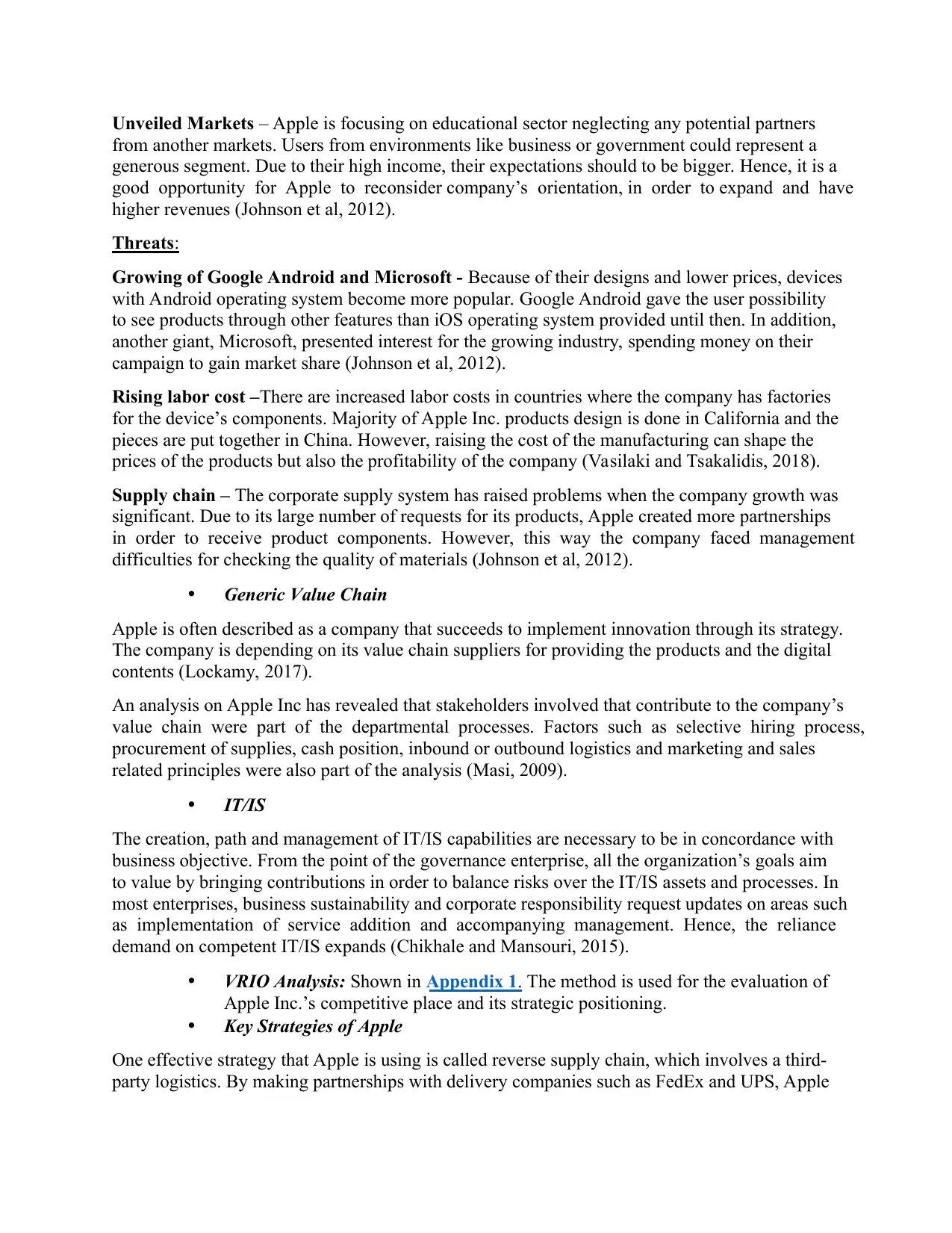
Unveiled Markets – Apple is focusing on educational sector neglecting any potential partners
from another markets. Users from environments like business or government could represent a
generous segment. Due to their high income, their expectations should to be bigger. Hence, it is a
good opportunity for Apple to reconsider company’s orientation, in order to expand and have
higher revenues (Johnson et al, 2012).
Threats:
Growing of Google Android and Microsoft - Because of their designs and lower prices, devices
with Android operating system become more popular. Google Android gave the user possibility
to see products through other features than iOS operating system provided until then. In addition,
another giant, Microsoft, presented interest for the growing industry, spending money on their
campaign to gain market share (Johnson et al, 2012).
Rising labor cost –There are increased labor costs in countries where the company has factories
for the device’s components. Majority of Apple Inc. products design is done in California and the
pieces are put together in China. However, raising the cost of the manufacturing can shape the
prices of the products but also the profitability of the company (Vasilaki and Tsakalidis, 2018).
Supply chain – The corporate supply system has raised problems when the company growth was
significant. Due to its large number of requests for its products, Apple created more partnerships
in order to receive product components. However, this way the company faced management
difficulties for checking the quality of materials (Johnson et al, 2012).
• Generic Value Chain
Apple is often described as a company that succeeds to implement innovation through its strategy.
The company is depending on its value chain suppliers for providing the products and the digital
contents (Lockamy, 2017).
An analysis on Apple Inc has revealed that stakeholders involved that contribute to the company’s
value chain were part of the departmental processes. Factors such as selective hiring process,
procurement of supplies, cash position, inbound or outbound logistics and marketing and sales
related principles were also part of the analysis (Masi, 2009).
• IT/IS
The creation, path and management of IT/IS capabilities are necessary to be in concordance with
business objective. From the point of the governance enterprise, all the organization’s goals aim
to value by bringing contributions in order to balance risks over the IT/IS assets and processes. In
most enterprises, business sustainability and corporate responsibility request updates on areas such
as implementation of service addition and accompanying management. Hence, the reliance
demand on competent IT/IS expands (Chikhale and Mansouri, 2015).
• VRIO Analysis: Shown in Appendix 1. The method is used for the evaluation of
Apple Inc.’s competitive place and its strategic positioning.
• Key Strategies of Apple
One effective strategy that Apple is using is called reverse supply chain, which involves a third-
party logistics. By making partnerships with delivery companies such as FedEx and UPS, Apple
from another markets. Users from environments like business or government could represent a
generous segment. Due to their high income, their expectations should to be bigger. Hence, it is a
good opportunity for Apple to reconsider company’s orientation, in order to expand and have
higher revenues (Johnson et al, 2012).
Threats:
Growing of Google Android and Microsoft - Because of their designs and lower prices, devices
with Android operating system become more popular. Google Android gave the user possibility
to see products through other features than iOS operating system provided until then. In addition,
another giant, Microsoft, presented interest for the growing industry, spending money on their
campaign to gain market share (Johnson et al, 2012).
Rising labor cost –There are increased labor costs in countries where the company has factories
for the device’s components. Majority of Apple Inc. products design is done in California and the
pieces are put together in China. However, raising the cost of the manufacturing can shape the
prices of the products but also the profitability of the company (Vasilaki and Tsakalidis, 2018).
Supply chain – The corporate supply system has raised problems when the company growth was
significant. Due to its large number of requests for its products, Apple created more partnerships
in order to receive product components. However, this way the company faced management
difficulties for checking the quality of materials (Johnson et al, 2012).
• Generic Value Chain
Apple is often described as a company that succeeds to implement innovation through its strategy.
The company is depending on its value chain suppliers for providing the products and the digital
contents (Lockamy, 2017).
An analysis on Apple Inc has revealed that stakeholders involved that contribute to the company’s
value chain were part of the departmental processes. Factors such as selective hiring process,
procurement of supplies, cash position, inbound or outbound logistics and marketing and sales
related principles were also part of the analysis (Masi, 2009).
• IT/IS
The creation, path and management of IT/IS capabilities are necessary to be in concordance with
business objective. From the point of the governance enterprise, all the organization’s goals aim
to value by bringing contributions in order to balance risks over the IT/IS assets and processes. In
most enterprises, business sustainability and corporate responsibility request updates on areas such
as implementation of service addition and accompanying management. Hence, the reliance
demand on competent IT/IS expands (Chikhale and Mansouri, 2015).
• VRIO Analysis: Shown in Appendix 1. The method is used for the evaluation of
Apple Inc.’s competitive place and its strategic positioning.
• Key Strategies of Apple
One effective strategy that Apple is using is called reverse supply chain, which involves a third-
party logistics. By making partnerships with delivery companies such as FedEx and UPS, Apple
⊘ This is a preview!⊘
Do you want full access?
Subscribe today to unlock all pages.

Trusted by 1+ million students worldwide
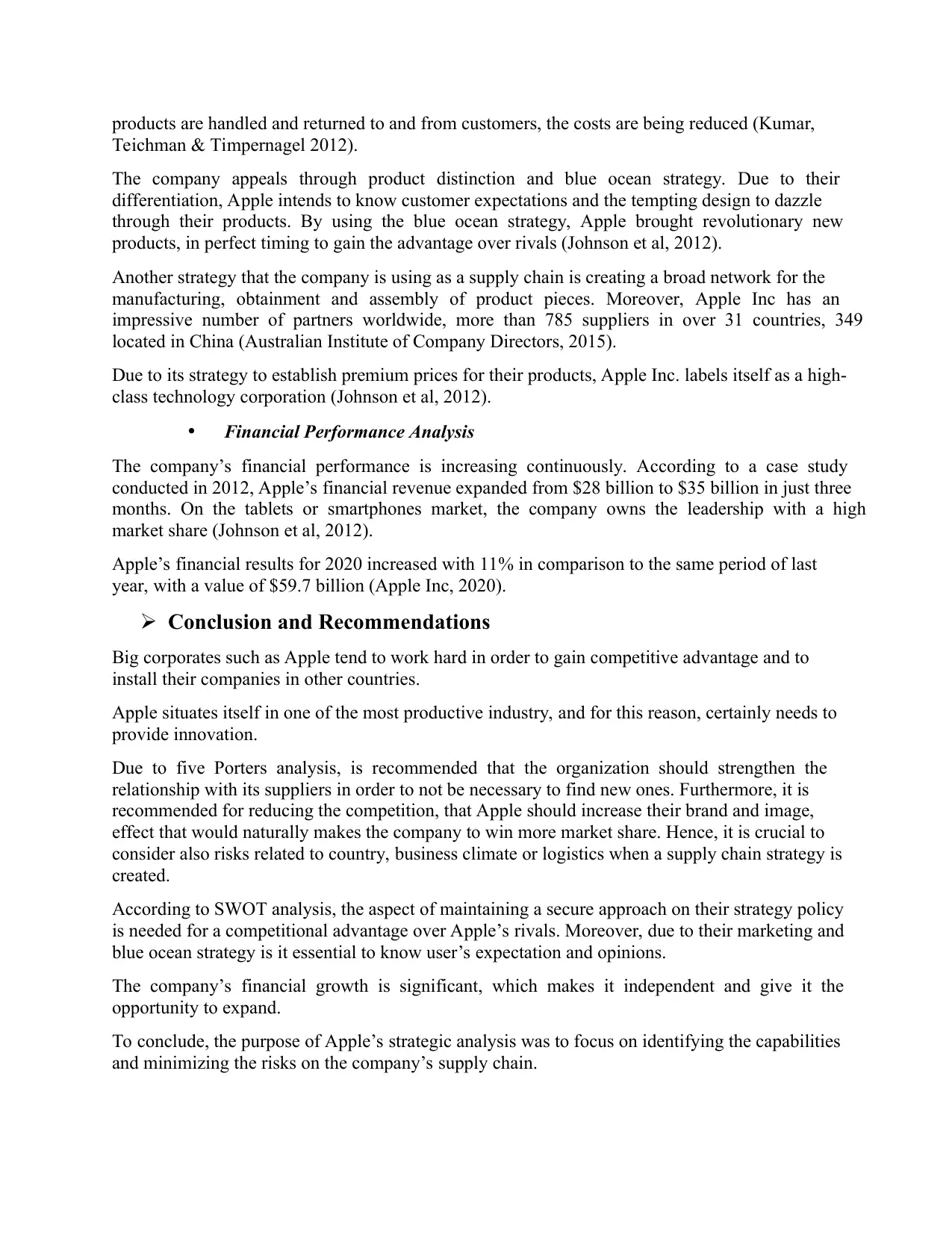
products are handled and returned to and from customers, the costs are being reduced (Kumar,
Teichman & Timpernagel 2012).
The company appeals through product distinction and blue ocean strategy. Due to their
differentiation, Apple intends to know customer expectations and the tempting design to dazzle
through their products. By using the blue ocean strategy, Apple brought revolutionary new
products, in perfect timing to gain the advantage over rivals (Johnson et al, 2012).
Another strategy that the company is using as a supply chain is creating a broad network for the
manufacturing, obtainment and assembly of product pieces. Moreover, Apple Inc has an
impressive number of partners worldwide, more than 785 suppliers in over 31 countries, 349
located in China (Australian Institute of Company Directors, 2015).
Due to its strategy to establish premium prices for their products, Apple Inc. labels itself as a high-
class technology corporation (Johnson et al, 2012).
• Financial Performance Analysis
The company’s financial performance is increasing continuously. According to a case study
conducted in 2012, Apple’s financial revenue expanded from $28 billion to $35 billion in just three
months. On the tablets or smartphones market, the company owns the leadership with a high
market share (Johnson et al, 2012).
Apple’s financial results for 2020 increased with 11% in comparison to the same period of last
year, with a value of $59.7 billion (Apple Inc, 2020).
Conclusion and Recommendations
Big corporates such as Apple tend to work hard in order to gain competitive advantage and to
install their companies in other countries.
Apple situates itself in one of the most productive industry, and for this reason, certainly needs to
provide innovation.
Due to five Porters analysis, is recommended that the organization should strengthen the
relationship with its suppliers in order to not be necessary to find new ones. Furthermore, it is
recommended for reducing the competition, that Apple should increase their brand and image,
effect that would naturally makes the company to win more market share. Hence, it is crucial to
consider also risks related to country, business climate or logistics when a supply chain strategy is
created.
According to SWOT analysis, the aspect of maintaining a secure approach on their strategy policy
is needed for a competitional advantage over Apple’s rivals. Moreover, due to their marketing and
blue ocean strategy is it essential to know user’s expectation and opinions.
The company’s financial growth is significant, which makes it independent and give it the
opportunity to expand.
To conclude, the purpose of Apple’s strategic analysis was to focus on identifying the capabilities
and minimizing the risks on the company’s supply chain.
Teichman & Timpernagel 2012).
The company appeals through product distinction and blue ocean strategy. Due to their
differentiation, Apple intends to know customer expectations and the tempting design to dazzle
through their products. By using the blue ocean strategy, Apple brought revolutionary new
products, in perfect timing to gain the advantage over rivals (Johnson et al, 2012).
Another strategy that the company is using as a supply chain is creating a broad network for the
manufacturing, obtainment and assembly of product pieces. Moreover, Apple Inc has an
impressive number of partners worldwide, more than 785 suppliers in over 31 countries, 349
located in China (Australian Institute of Company Directors, 2015).
Due to its strategy to establish premium prices for their products, Apple Inc. labels itself as a high-
class technology corporation (Johnson et al, 2012).
• Financial Performance Analysis
The company’s financial performance is increasing continuously. According to a case study
conducted in 2012, Apple’s financial revenue expanded from $28 billion to $35 billion in just three
months. On the tablets or smartphones market, the company owns the leadership with a high
market share (Johnson et al, 2012).
Apple’s financial results for 2020 increased with 11% in comparison to the same period of last
year, with a value of $59.7 billion (Apple Inc, 2020).
Conclusion and Recommendations
Big corporates such as Apple tend to work hard in order to gain competitive advantage and to
install their companies in other countries.
Apple situates itself in one of the most productive industry, and for this reason, certainly needs to
provide innovation.
Due to five Porters analysis, is recommended that the organization should strengthen the
relationship with its suppliers in order to not be necessary to find new ones. Furthermore, it is
recommended for reducing the competition, that Apple should increase their brand and image,
effect that would naturally makes the company to win more market share. Hence, it is crucial to
consider also risks related to country, business climate or logistics when a supply chain strategy is
created.
According to SWOT analysis, the aspect of maintaining a secure approach on their strategy policy
is needed for a competitional advantage over Apple’s rivals. Moreover, due to their marketing and
blue ocean strategy is it essential to know user’s expectation and opinions.
The company’s financial growth is significant, which makes it independent and give it the
opportunity to expand.
To conclude, the purpose of Apple’s strategic analysis was to focus on identifying the capabilities
and minimizing the risks on the company’s supply chain.
Paraphrase This Document
Need a fresh take? Get an instant paraphrase of this document with our AI Paraphraser
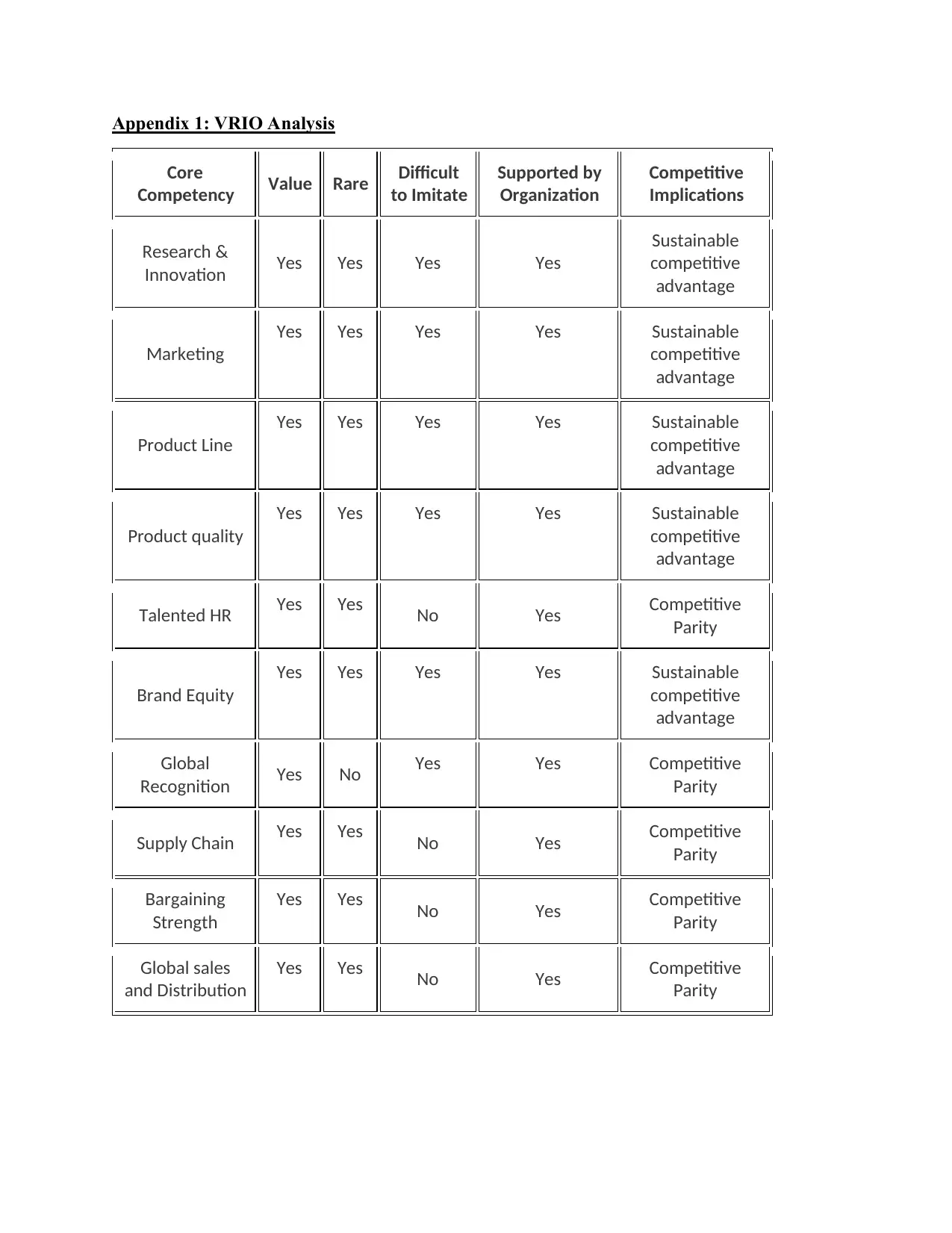
Appendix 1: VRIO Analysis
Core
Competency Value Rare Difficult
to Imitate
Supported by
Organization
Competitive
Implications
Research &
Innovation Yes Yes Yes Yes
Sustainable
competitive
advantage
Marketing
Yes Yes Yes Yes Sustainable
competitive
advantage
Product Line
Yes Yes Yes Yes Sustainable
competitive
advantage
Product quality
Yes Yes Yes Yes Sustainable
competitive
advantage
Talented HR Yes Yes No Yes Competitive
Parity
Brand Equity
Yes Yes Yes Yes Sustainable
competitive
advantage
Global
Recognition Yes No Yes Yes Competitive
Parity
Supply Chain Yes Yes No Yes Competitive
Parity
Bargaining
Strength
Yes Yes No Yes Competitive
Parity
Global sales
and Distribution
Yes Yes No Yes Competitive
Parity
Core
Competency Value Rare Difficult
to Imitate
Supported by
Organization
Competitive
Implications
Research &
Innovation Yes Yes Yes Yes
Sustainable
competitive
advantage
Marketing
Yes Yes Yes Yes Sustainable
competitive
advantage
Product Line
Yes Yes Yes Yes Sustainable
competitive
advantage
Product quality
Yes Yes Yes Yes Sustainable
competitive
advantage
Talented HR Yes Yes No Yes Competitive
Parity
Brand Equity
Yes Yes Yes Yes Sustainable
competitive
advantage
Global
Recognition Yes No Yes Yes Competitive
Parity
Supply Chain Yes Yes No Yes Competitive
Parity
Bargaining
Strength
Yes Yes No Yes Competitive
Parity
Global sales
and Distribution
Yes Yes No Yes Competitive
Parity
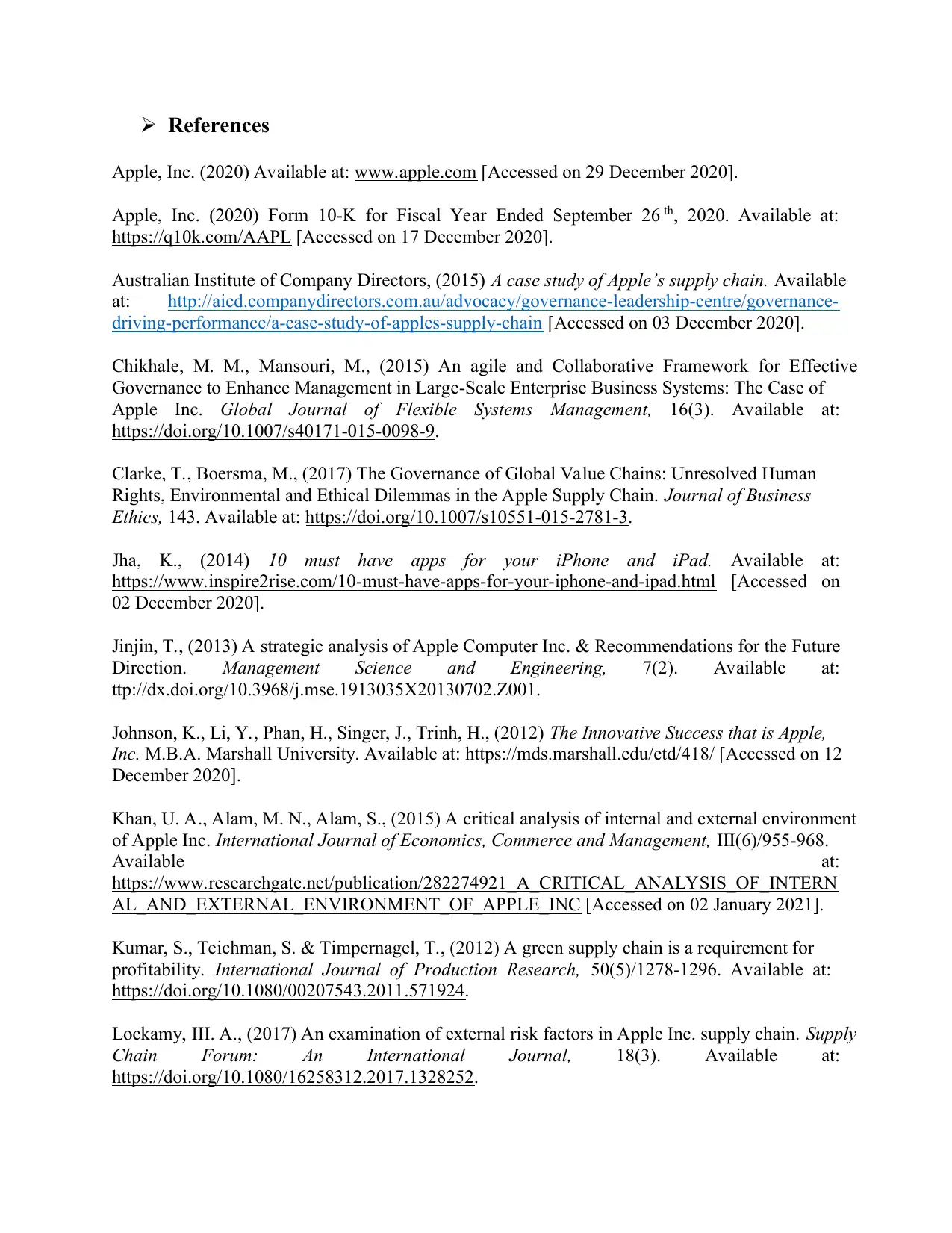
References
Apple, Inc. (2020) Available at: www.apple.com [Accessed on 29 December 2020].
Apple, Inc. (2020) Form 10-K for Fiscal Year Ended September 26 th, 2020. Available at:
https://q10k.com/AAPL [Accessed on 17 December 2020].
Australian Institute of Company Directors, (2015) A case study of Apple’s supply chain. Available
at: http://aicd.companydirectors.com.au/advocacy/governance-leadership-centre/governance-
driving-performance/a-case-study-of-apples-supply-chain [Accessed on 03 December 2020].
Chikhale, M. M., Mansouri, M., (2015) An agile and Collaborative Framework for Effective
Governance to Enhance Management in Large-Scale Enterprise Business Systems: The Case of
Apple Inc. Global Journal of Flexible Systems Management, 16(3). Available at:
https://doi.org/10.1007/s40171-015-0098-9.
Clarke, T., Boersma, M., (2017) The Governance of Global Value Chains: Unresolved Human
Rights, Environmental and Ethical Dilemmas in the Apple Supply Chain. Journal of Business
Ethics, 143. Available at: https://doi.org/10.1007/s10551-015-2781-3.
Jha, K., (2014) 10 must have apps for your iPhone and iPad. Available at:
https://www.inspire2rise.com/10-must-have-apps-for-your-iphone-and-ipad.html [Accessed on
02 December 2020].
Jinjin, T., (2013) A strategic analysis of Apple Computer Inc. & Recommendations for the Future
Direction. Management Science and Engineering, 7(2). Available at:
ttp://dx.doi.org/10.3968/j.mse.1913035X20130702.Z001.
Johnson, K., Li, Y., Phan, H., Singer, J., Trinh, H., (2012) The Innovative Success that is Apple,
Inc. M.B.A. Marshall University. Available at: https://mds.marshall.edu/etd/418/ [Accessed on 12
December 2020].
Khan, U. A., Alam, M. N., Alam, S., (2015) A critical analysis of internal and external environment
of Apple Inc. International Journal of Economics, Commerce and Management, III(6)/955-968.
Available at:
https://www.researchgate.net/publication/282274921_A_CRITICAL_ANALYSIS_OF_INTERN
AL_AND_EXTERNAL_ENVIRONMENT_OF_APPLE_INC [Accessed on 02 January 2021].
Kumar, S., Teichman, S. & Timpernagel, T., (2012) A green supply chain is a requirement for
profitability. International Journal of Production Research, 50(5)/1278-1296. Available at:
https://doi.org/10.1080/00207543.2011.571924.
Lockamy, III. A., (2017) An examination of external risk factors in Apple Inc. supply chain. Supply
Chain Forum: An International Journal, 18(3). Available at:
https://doi.org/10.1080/16258312.2017.1328252.
Apple, Inc. (2020) Available at: www.apple.com [Accessed on 29 December 2020].
Apple, Inc. (2020) Form 10-K for Fiscal Year Ended September 26 th, 2020. Available at:
https://q10k.com/AAPL [Accessed on 17 December 2020].
Australian Institute of Company Directors, (2015) A case study of Apple’s supply chain. Available
at: http://aicd.companydirectors.com.au/advocacy/governance-leadership-centre/governance-
driving-performance/a-case-study-of-apples-supply-chain [Accessed on 03 December 2020].
Chikhale, M. M., Mansouri, M., (2015) An agile and Collaborative Framework for Effective
Governance to Enhance Management in Large-Scale Enterprise Business Systems: The Case of
Apple Inc. Global Journal of Flexible Systems Management, 16(3). Available at:
https://doi.org/10.1007/s40171-015-0098-9.
Clarke, T., Boersma, M., (2017) The Governance of Global Value Chains: Unresolved Human
Rights, Environmental and Ethical Dilemmas in the Apple Supply Chain. Journal of Business
Ethics, 143. Available at: https://doi.org/10.1007/s10551-015-2781-3.
Jha, K., (2014) 10 must have apps for your iPhone and iPad. Available at:
https://www.inspire2rise.com/10-must-have-apps-for-your-iphone-and-ipad.html [Accessed on
02 December 2020].
Jinjin, T., (2013) A strategic analysis of Apple Computer Inc. & Recommendations for the Future
Direction. Management Science and Engineering, 7(2). Available at:
ttp://dx.doi.org/10.3968/j.mse.1913035X20130702.Z001.
Johnson, K., Li, Y., Phan, H., Singer, J., Trinh, H., (2012) The Innovative Success that is Apple,
Inc. M.B.A. Marshall University. Available at: https://mds.marshall.edu/etd/418/ [Accessed on 12
December 2020].
Khan, U. A., Alam, M. N., Alam, S., (2015) A critical analysis of internal and external environment
of Apple Inc. International Journal of Economics, Commerce and Management, III(6)/955-968.
Available at:
https://www.researchgate.net/publication/282274921_A_CRITICAL_ANALYSIS_OF_INTERN
AL_AND_EXTERNAL_ENVIRONMENT_OF_APPLE_INC [Accessed on 02 January 2021].
Kumar, S., Teichman, S. & Timpernagel, T., (2012) A green supply chain is a requirement for
profitability. International Journal of Production Research, 50(5)/1278-1296. Available at:
https://doi.org/10.1080/00207543.2011.571924.
Lockamy, III. A., (2017) An examination of external risk factors in Apple Inc. supply chain. Supply
Chain Forum: An International Journal, 18(3). Available at:
https://doi.org/10.1080/16258312.2017.1328252.
⊘ This is a preview!⊘
Do you want full access?
Subscribe today to unlock all pages.

Trusted by 1+ million students worldwide
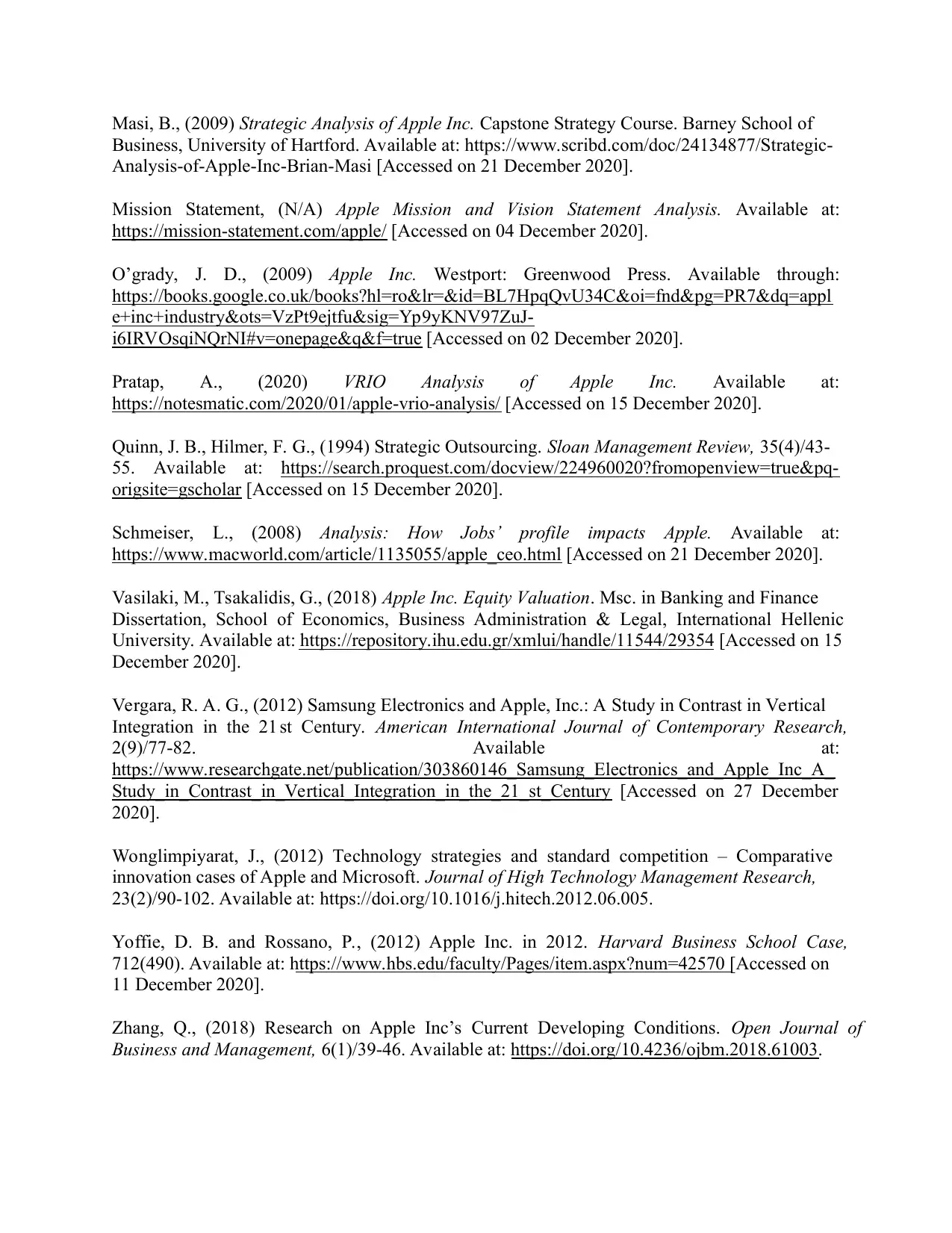
Masi, B., (2009) Strategic Analysis of Apple Inc. Capstone Strategy Course. Barney School of
Business, University of Hartford. Available at: https://www.scribd.com/doc/24134877/Strategic-
Analysis-of-Apple-Inc-Brian-Masi [Accessed on 21 December 2020].
Mission Statement, (N/A) Apple Mission and Vision Statement Analysis. Available at:
https://mission-statement.com/apple/ [Accessed on 04 December 2020].
O’grady, J. D., (2009) Apple Inc. Westport: Greenwood Press. Available through:
https://books.google.co.uk/books?hl=ro&lr=&id=BL7HpqQvU34C&oi=fnd&pg=PR7&dq=appl
e+inc+industry&ots=VzPt9ejtfu&sig=Yp9yKNV97ZuJ-
i6IRVOsqiNQrNI#v=onepage&q&f=true [Accessed on 02 December 2020].
Pratap, A., (2020) VRIO Analysis of Apple Inc. Available at:
https://notesmatic.com/2020/01/apple-vrio-analysis/ [Accessed on 15 December 2020].
Quinn, J. B., Hilmer, F. G., (1994) Strategic Outsourcing. Sloan Management Review, 35(4)/43-
55. Available at: https://search.proquest.com/docview/224960020?fromopenview=true&pq-
origsite=gscholar [Accessed on 15 December 2020].
Schmeiser, L., (2008) Analysis: How Jobs’ profile impacts Apple. Available at:
https://www.macworld.com/article/1135055/apple_ceo.html [Accessed on 21 December 2020].
Vasilaki, M., Tsakalidis, G., (2018) Apple Inc. Equity Valuation. Msc. in Banking and Finance
Dissertation, School of Economics, Business Administration & Legal, International Hellenic
University. Available at: https://repository.ihu.edu.gr/xmlui/handle/11544/29354 [Accessed on 15
December 2020].
Vergara, R. A. G., (2012) Samsung Electronics and Apple, Inc.: A Study in Contrast in Vertical
Integration in the 21 st Century. American International Journal of Contemporary Research,
2(9)/77-82. Available at:
https://www.researchgate.net/publication/303860146_Samsung_Electronics_and_Apple_Inc_A_
Study_in_Contrast_in_Vertical_Integration_in_the_21_st_Century [Accessed on 27 December
2020].
Wonglimpiyarat, J., (2012) Technology strategies and standard competition – Comparative
innovation cases of Apple and Microsoft. Journal of High Technology Management Research,
23(2)/90-102. Available at: https://doi.org/10.1016/j.hitech.2012.06.005.
Yoffie, D. B. and Rossano, P., (2012) Apple Inc. in 2012. Harvard Business School Case,
712(490). Available at: https://www.hbs.edu/faculty/Pages/item.aspx?num=42570 [Accessed on
11 December 2020].
Zhang, Q., (2018) Research on Apple Inc’s Current Developing Conditions. Open Journal of
Business and Management, 6(1)/39-46. Available at: https://doi.org/10.4236/ojbm.2018.61003.
Business, University of Hartford. Available at: https://www.scribd.com/doc/24134877/Strategic-
Analysis-of-Apple-Inc-Brian-Masi [Accessed on 21 December 2020].
Mission Statement, (N/A) Apple Mission and Vision Statement Analysis. Available at:
https://mission-statement.com/apple/ [Accessed on 04 December 2020].
O’grady, J. D., (2009) Apple Inc. Westport: Greenwood Press. Available through:
https://books.google.co.uk/books?hl=ro&lr=&id=BL7HpqQvU34C&oi=fnd&pg=PR7&dq=appl
e+inc+industry&ots=VzPt9ejtfu&sig=Yp9yKNV97ZuJ-
i6IRVOsqiNQrNI#v=onepage&q&f=true [Accessed on 02 December 2020].
Pratap, A., (2020) VRIO Analysis of Apple Inc. Available at:
https://notesmatic.com/2020/01/apple-vrio-analysis/ [Accessed on 15 December 2020].
Quinn, J. B., Hilmer, F. G., (1994) Strategic Outsourcing. Sloan Management Review, 35(4)/43-
55. Available at: https://search.proquest.com/docview/224960020?fromopenview=true&pq-
origsite=gscholar [Accessed on 15 December 2020].
Schmeiser, L., (2008) Analysis: How Jobs’ profile impacts Apple. Available at:
https://www.macworld.com/article/1135055/apple_ceo.html [Accessed on 21 December 2020].
Vasilaki, M., Tsakalidis, G., (2018) Apple Inc. Equity Valuation. Msc. in Banking and Finance
Dissertation, School of Economics, Business Administration & Legal, International Hellenic
University. Available at: https://repository.ihu.edu.gr/xmlui/handle/11544/29354 [Accessed on 15
December 2020].
Vergara, R. A. G., (2012) Samsung Electronics and Apple, Inc.: A Study in Contrast in Vertical
Integration in the 21 st Century. American International Journal of Contemporary Research,
2(9)/77-82. Available at:
https://www.researchgate.net/publication/303860146_Samsung_Electronics_and_Apple_Inc_A_
Study_in_Contrast_in_Vertical_Integration_in_the_21_st_Century [Accessed on 27 December
2020].
Wonglimpiyarat, J., (2012) Technology strategies and standard competition – Comparative
innovation cases of Apple and Microsoft. Journal of High Technology Management Research,
23(2)/90-102. Available at: https://doi.org/10.1016/j.hitech.2012.06.005.
Yoffie, D. B. and Rossano, P., (2012) Apple Inc. in 2012. Harvard Business School Case,
712(490). Available at: https://www.hbs.edu/faculty/Pages/item.aspx?num=42570 [Accessed on
11 December 2020].
Zhang, Q., (2018) Research on Apple Inc’s Current Developing Conditions. Open Journal of
Business and Management, 6(1)/39-46. Available at: https://doi.org/10.4236/ojbm.2018.61003.
1 out of 10
Related Documents
Your All-in-One AI-Powered Toolkit for Academic Success.
+13062052269
info@desklib.com
Available 24*7 on WhatsApp / Email
![[object Object]](/_next/static/media/star-bottom.7253800d.svg)
Unlock your academic potential
Copyright © 2020–2025 A2Z Services. All Rights Reserved. Developed and managed by ZUCOL.





